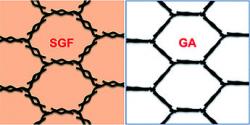A team of researchers at the University of California report on the preparation of a graphene hydrogel, which can be converted into solvated graphene frameworks that are stable 3D porous structures offering both fast lithium exchange and high conductivity. Using these frameworks as anode material, it is possible to assemble a lithium coin cell, with excellent capacities surpassing conventional graphite materials.

To prepare the graphene frameworks, the scientists used a modified hydrothermal method to generate free-standing cubes of a graphene hydrogel from graphite oxide. Solvent exchange converted the hydrogel structures into the 3D solvated graphene frameworks, which can be pressed in films needed for the coin cells without losing their porous graphene network. These anodes not only provided for much faster lithium diffusion, but also retained the large surface area and excellent conductivity of graphene sheets.
The scientists emphasize that their research also has a more general impact on battery technology as the "fundamental insights" will "promote the rational design and synthesis of 3D graphene materials for electrochemical energy storage and beyond."

